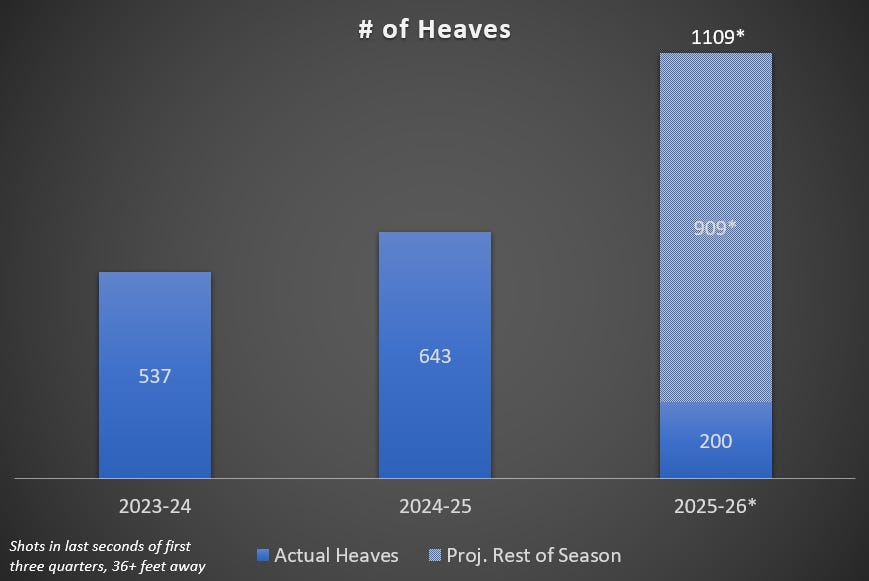Rewarding "cowards:" How many more heaves are we seeing?
Don't hate the players, hate the game
The NBA implemented a controversial change in the offseason, changing their stat-tracking so that any shots defined as “heaves” would no longer count against individual player field goal percentage. They would instead be counted as “team” shots without an assigned shooter.
The basketball intelligentsia mostly hated this minor update, claiming it rewarded “cowardly” players who didn’t want to destroy their field goal percentage. Even Zach Lowe vehemently came out against it!
I get the knee-jerk reaction. I hold the same distaste towards players holding onto the ball a second too long before half-heartedly flinging the ball to nowhere in particular after the buzzer sounds. It’s annoying!
But the new rule is an overwhelming positive that should be celebrated, not castigated.
Long-time Basketball Poetry readers have known for a while that the old way of counting heaves was genuinely punitive to the shooters. Two seasons ago, Naji Marshall led the league with 14 half-court shots. They all missed, bringing his three-point percentage down from 34.7% to 33.7%. That might not seem like a lot to you, and typically, NBA personnel know enough to exclude those kinds of shots from their internal numbers when evaluating performance.
But there are plenty of high-level decision-makers who still rely upon the old-fashioned basketball slash line (like, say, non-analytically driven owners, who have to sign off on any contract or trade), to say nothing of the millions of fans who form box-score-driven opinions of players. Even a metric like true shooting typically includes heaves (at least, in the public-facing sphere), and if you don’t think front offices are using Basketball-Reference for convenience’s sake, think again.
For anyone, it’s much easier to look up the face-level percentages and assume that heaves don’t matter all that much — which was often true, since players generally weren’t heaving, since they know all that! It’s a little chicken-or-eggy.
At best, heave-happy players take a dent in the public eye. At worst, a percentage or two of three-point percentage could cost a player millions. That may be an unlikely outcome, but players and agents certainly don’t want to take the risk! Hard to blame them for that.
Last year alone, Nikola Jokic famously went 2/22 on half-court shots. Removing those misses, as they would be counted today, would’ve raised his three-point percentage from 41.7% to 44.4%. That’s a -2.7% delta. It doesn’t matter for a supermax player like Jokic, but to expect any sub-max player to sacrifice their three-point percentage so substantially (thus lowering their value) is absurd.
I lauded Marshall for his willingness to do so, but it’s hard to blame the non-heavers too much. The basketball purist wants everyone to play like winning is the only thing that matters, but this is a job. A few extra misses here and there in a three-point-obsessed league can literally cost you. Don’t pretend like you wouldn’t do the same thing, particularly when such behavior has become normalized. It’s unreasonable to expect otherwise.
Anyway, the NBA tested the new heave rule out in the G-League first, and now it’s made it to the big league. (There is also some precedent for this kind of change, as the league has counted shot-clock violations as team violations without an individual offender for years.) And thank goodness! Everyone loves buzzer-beaters.
I wanted to examine just what kind of impact this would have. Obviously, this rule would lead to more heaves, but I wasn’t sure to what extent.
Using play-by-play data from the league, I looked at shots that fell into the league’s definition of a heave: 36+ feet within the final few seconds1 of the first three quarters.
With data through 11/19 (compiled Thursday morning), 222 games have been played in the NBA thus far. I compared that to the 1231 games played last year and the year before (including the NBA Cup Championship, because why not), and found heaves have roughly doubled:
200 heaves in 222 games is pretty good compared to the 500-600 we saw in the prior two seasons. At this rate, we’d expect about 1,100 heaves total, although I think that’s probably a conservative estimate. I’ve seen at least a few players still not launch at the end of a quarter, likely because they didn’t remember the rule change. As players gain more familiarity, they’ll become more willing heavers.
Doubling is a significant increase, but perhaps not quite as dramatic as I personally expected. That might be because we were already “heaving” more than I realized, at least as the NBA defines it now. Before, there was one heave roughly every other game; now, you’d expect to see one in any contest.
But then I had another thought: Are players shooting less often from the space around the 36-foot heave border? Are they shying away from slightly better shots to preserve their percentages?


